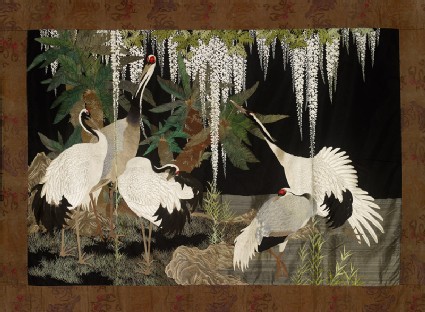Search Results: objects
Show search help- Reference URL
Actions
Cranes, cycads, and wisteria
-
Description
This superb hanging was presented to the Ashmolean Museum in 1958 by Sir Herbert Ingram, who travelled to Japan on his honeymoon in 1908. It is possible that this piece was purchased then. Cranes were popular symbols of longevity and a perfect subject for a newly-married couple. The trailing wisteria blossoms are carefully placed to disguise the joins between the four panels of this hanging. (Exhibition number 19)
-
Details
- Associated place
-
Asia › Japan › Honshū › Kyōto prefecture › Kyoto › Muromachi Suji (possible place of creation)
- Date
-
c. 1905
Meiji Period (1868 - 1912)
- Artist/maker
-
probably Nishimura Sōzaemon (established c. 1670)
- Material and technique
- obverse: shioze (ribbed silk), dyed black, and embroidered with coloured silk, flat silk, and paper-backed gold foil wrapped around a silk or cotton core; brown silk brocade border reverse: cotton, with freehand paste-resist decoration (tsutsugaki)
- Dimensions
- 205 x 278 cm (height x width)
- Material index
-
organic › animal › animal product › silk,processed material › metal › gold,
- Technique index
-
dyed,
- Object type index
- No. of items
- 1
- Credit line
- Presented by Sir Herbert Ingram, 1956.
- Accession no.
- EA1958.81
-
Further reading
Impey, Oliver, and Joyce Seaman, Japanese Decorative Arts of the Meiji Period 1868-1912, Ashmolean Handbooks (Oxford: Ashmolean Museum, 2005), no. 2 on p. 12, illus. p. 13
Impey, Oliver, ‘Reflections upon the Arts and Crafts of Meiji Period Japan with Reference to the Collection of the Ashmolean Museum’, Oriental Art, 42/3, (Autumn 1996), p. 12, illus. p. 12 fig. 2
Oxford: Ashmolean Museum, 9 November 2012-27 January 2013, Threads of Silk and Gold: Ornamental Textiles from Meiji Japan, Clare Pollard, ed. (Oxford: Ashmolean Museum, 2012), no. 19 on p. 116, p. 6, illus. pp. 116-119
Glossary
tsutsugaki
-
tsutsugaki
A method of resist dyeing, in which areas of cloth are painted with starch paste, applied through a bamboo tube (tsutsu), to protect them from the dye
Past Exhibition
see (1)-

Threads of Silk and Gold: Ornamental Textiles from Meiji Japan
(from 9th Nov 2012 until 27th Jan 2013)
Location
-
- currently in research collection
Objects are sometimes moved to a different location. Our object location data is usually updated on a monthly basis. Contact the Jameel Study Centre if you are planning to visit the museum to see a particular object on display, or would like to arrange an appointment to see an object in our reserve collections.
Publications online
-

Japanese Decorative Arts of the Meiji Period
Large silk hanging embroidered in coloured silks, within a silk and metal thread brocade border. The whole backed with a cotton tsutsugaki fabric. The design of five Japanese Cranes (Grus japonica; Japanese tanchō) standing on rocks and grass amid cycads and white wisteria. The added border has a repeating dragon motif and the reverse, stylized chrysanthemum flowers. The four panels were carefully designed to compose one large piece, not a four-fold screen, by the careful placing of the extra-long inflorescences of the wisteria along the joins.
The ground fabric is a black, finely ribbed silk. The embroidery is mainly satin stitch, couching stitching and knotwork. The range of textures is achieved through the use of threads of various thicknesses and varying degrees of twist. The glossy feathers, for example, are stitched with floss silk of practically no twist, whereas the rougher bark and rocks are worked in a combination of loosely and tightly twisted threads. Clusters of knots create moss and lichen texture on the rocks. The direction of the stitches reflects the natural growth patterns of feathers and the scaly nature of the cranes’ legs and feet. The effect of the water surface in the lower right of the embroidery is achieved by individually couching down the long and extremely fine silk threads and incorporating slightly thicker threads to form the pattern of ripples.
It is impossible to identify this magnificent and high-quality panel with any entry in Ingram’s somewhat perfunctory diary, or his list of purchases made in 1908. This is surprising as it would have been extremely expensive; it may not have been bought on this trip.
© 2013 University of Oxford - Ashmolean Museum



